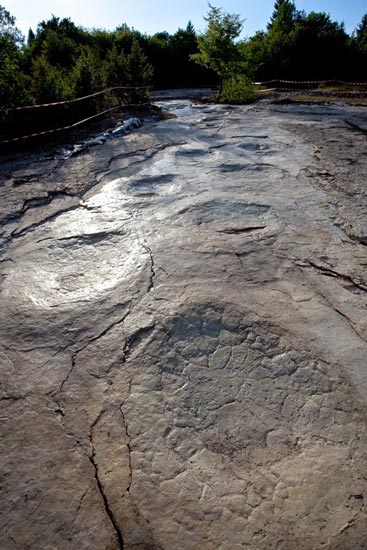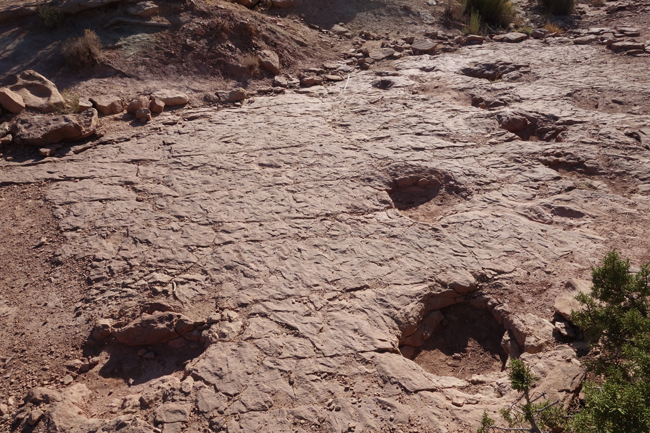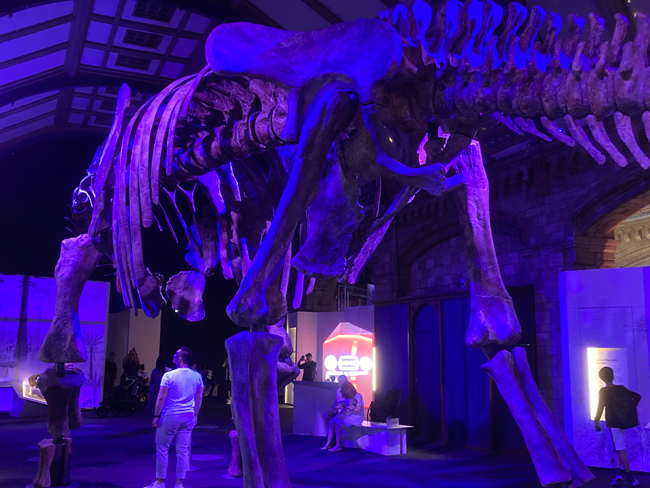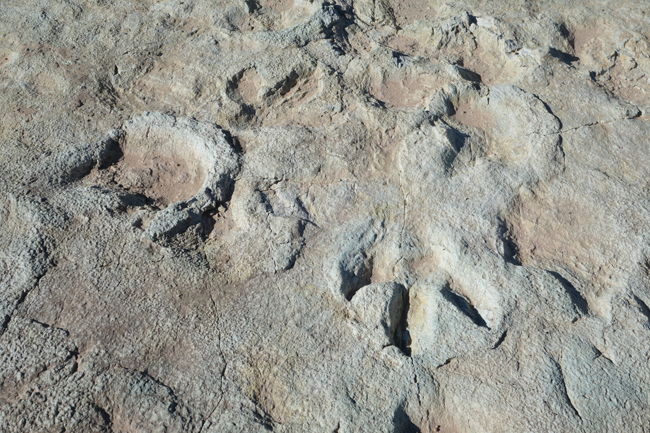Sauropods Walked Like Hippos According to New Study
Researchers from Liverpool John Moores University have developed a new and innovative approach to interpreting sauropod trackways enabling them to calculate their gaits (the order in which the animal moved its four limbs to progress). Jens Lallensack and his colleague Peter Falkingham discovered that the placement of tracks relative to each other in a sauropod trackway changes in a consistent way when the animal changes its velocity (either speeding up or slowing down). Using this technique, subsequently verified by analysing the gaits of living animals such as dogs, horses, a camel and an elephant, the scientists have concluded that sauropods walked more like hippos than elephants.

A picture of the sauropod trackway (Plagne, France). Picture credit: P. Dumas/Centre National de la Recherche Scientifique.
Picture credit: P. Dumas/Centre National de la Recherche Scientifique.
Quadruped Locomotion
Four-footed animals (quadrupeds), may use different gaits such as trots, walks, and pace gaits. In a trot, one diagonal limb pair (e.g. hind right and front left) moves together, followed by the other limb pair. Many mammals use trots at faster gaits, but reptiles also use trots at slow speeds. In a pace gait, in contrast, the limbs on one side of the body (e.g. hind right and fore right) move together in a similar way as the locomotion of a camel.
In-between these extremes is the single foot gait, in which the time lag between fore and hind feet is equal – a good example of this type of locomotion is the movement of horses.
The movements of living animals can be observed, direct observation of extinct animals such as huge, long-necked, long-tailed sauropod dinosaurs is not possible, but data can be obtained by careful study of their fossilised prints and trackways.
Picture credit: Liverpool John Moores University
Examining Sauropod Tracksites
Liverpool John Moores University researchers Jens Lallensack and Peter Falkingham identified that the placement of an animal’s feet changes in a predictable and consistent way when the animal’s velocity changes. If a trackway is long enough and shows variation in stride length (indicating a change of speed), it is possible to calculate gaits and to gain an insight into how extinct animals moved.
Their predictions were confirmed in an analysis of the gaits of different types of living animal, including elephants, thanks to the help from locomotion expert Professor John Hutchinson (Royal Veterinary College, London), who provided elephant locomotion data. These new analytical methods were used to plot the limb movements along three sauropod trackways from the Lower Cretaceous De Queen Formation (Arkansas, USA). Although it is not possible to identify specific sauropod species (ichnospecies) from the De Queen Formation (Albian fauna stage) tracks, these trace fossils represent large, sauropod trackmakers (median average hind foot length 70-85 cm and maximum stride length 3.42 metres).
Commenting on the outcome of their findings, reported in the journal “Current Biology”, Dr Falkingham stated:
“Many researchers assumed that sauropods walked like elephants, with which they share many similarities, but that doesn’t appear to be the case.”

Researchers have found a way to identify the gait of sauropods by studying their tracks. Picture credit: Liverpool John Moores University.
Picture credit: Liverpool John Moores University
Sauropod Dinosaurs Compared to Elephants
As elephants are the largest living terrestrial animals alive today, it had been suggested that their locomotion was an appropriate analogy for the movement of sauropod dinosaurs. Elephants use a gait intermediate between the pace gait and the singlefoot, i.e. the two limbs on the same body side tend to swing together. The gait analysis, in the current study by contrast, revealed that sauropods instead employed a gait intermediate between the singlefoot and a trot: the opposite-side limbs tend to swing together.
Based on this data, sauropod dinosaurs had a similar gait to hippos.
To Sway or Not to Sway
If sauropods moved very differently compared to the largest land animals alive today, this suggests that these two types of animal with large body sizes evolved different solutions to locomotion. Sauropods, even the titanosaurs known for their narrower trackways when compared to other types of sauropod such as diplodocids and dicraeosaurids, have a much broader stance than elephants. Elephants place one foot almost directly in front of another producing surprisingly narrow tracks for such large animals. Sauropod trackways, in contrast, are much broader. Their particular gait allowed sauropods to have at least one foot on the ground on both the left and right sides of the body at all times, preventing swaying from side to side.

The enormous body of the titanosaur dwarfs visitors. Patagotitan mayorum skeletal reconstruction. Titanosaurs are known for their narrower tracks when compared to other types of sauropod but as many were much bigger than elephants, elephants do not make a good analogy for describing the gaits of titanosaurs or of sauropods generally. Picture credit: Everything Dinosaur.
Picture credit: Everything Dinosaur
Everything Dinosaur acknowledges the assistance of a media release from Liverpool John Moores University in the compilation of this article.
Lead author of the scientific paper Dr Jens Lallensack added:
“Sauropods chose a gait that maximised stability but still allowed for efficient walking”.
The scientific paper: “A new method to calculate limb phase from trackways reveals gaits of sauropod dinosaurs” by Jens N. Lallensack, Peter L. Falkingham published in Current Biology.
The Everything Dinosaur website: Dinosaur Toys.


